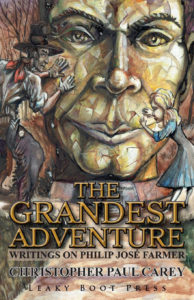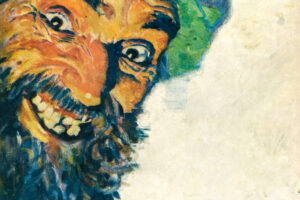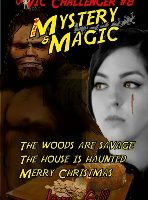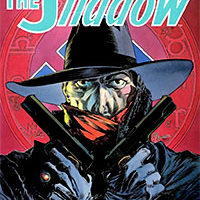 I am always looking for collections of non-fiction articles and works on the pulp magazines. While not purely pulp-based, Christopher Paul Carey‘s The Grandest Adventure (Leaky Book Press), a collection of writings related to the works on and about Philip José Farmer (1918-2009), is very enjoyable.
I am always looking for collections of non-fiction articles and works on the pulp magazines. While not purely pulp-based, Christopher Paul Carey‘s The Grandest Adventure (Leaky Book Press), a collection of writings related to the works on and about Philip José Farmer (1918-2009), is very enjoyable.
Farmer was a master sf author who was also a pulp fan. He wrote several works related to Doc Savage and Tarzan, including his biographies of them and several works making use of pastiches of them.
Also interesting is his works set in prehistoric Opar, the ancient work of Khokarsa, that not only was the originator of Opar, but also other lost race groups found by H. Rider Haggard. I’ve posted on these as well as his concept of the Wold Newton “family” and universe that ties together many fictional characters together.
This collection of works takes pieces that appeared in fanzines and various books over the the years. While all are focused on the works of PJF, several of them are of interest to pulp fans, especially those open to Farmer’s Wold Newton concepts. Carey has been heavily involved with Farmer’s work, in particular his expanding the Khokarsa works.
There are a couple of pieces tied to Doc Savage. Some appeared in the Bronze Gazette. They relate to Farmer’s Escape from Loki, which tells of Doc in WWI. There is also the afterward from the Meteor House edition of Doc Savage: His Apocalyptic Life.
A good chunk of the pieces here relate to Farmer’s Khokarsa works, which is not surprising as Carey was able to complete the unfinished trilogy and extend it. Farmer had written Hadon of Ancient Opar and Flight to Opar, set in the ancient empire of Khokarsa. Khokarsa was an island in an ancient and much larger prehistoric Lake Chad, and its civilization ruled over several cities along its coast and another connected inland sea within Africa some 12,000 years ago. Mixed in was Tarzan, who had gone back in time in the Farmer novel Time’s Last Gift.
Cary was able to complete the trilogy with The Song of Kwasin and do some further works. Thus we get several pieces, some being intros or aftewards from reprints of these works, or further examinations from various sources on the language and geology that Farmer created or drew from for these works. While I have some of these pieces, others I don’t. And it’s great to have them in one place.
There are articles on others of Farmers works, such as Two Hawks from Earth. But the pulp-related works take up the bulk of what is here. If you are interested in a better understanding and appreciating Farmer’s work, this is a good starting point.




Your comments